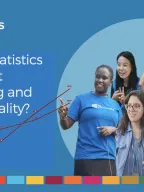What are the tools and approaches for measuring volunteer work?
About the discussion group
In this online discussion, we want to hear your views, experiences and questions on what can be done to improve the measurement of volunteer work across countries and different sectors.
Every day, in every country in the world, millions of volunteers work with communities, organizations, companies and on their own to take action on the issues that affect them. Throughout the global COVID-19 pandemic, volunteers have been at the frontlines of response efforts, from providing health services to raising awareness.
But how many people volunteer and what exactly do they do? The answers to these vital questions require data and evidence to measure the status, effectiveness and impact of volunteering.
On 4 March 2021, UNV and ILO conducted a webinar discussing the different tools and approaches for measuring volunteer work (View the recording and summary here). This discussion board aims to continue the rich discussions that took place in the webinar.

- Log in or register to post comments

In reply to (No subject) by Jhon Esteban

However, I have one primary concern/question. Could you explain the rationale for the addition of the questions on time spent buying, collecting, or distributing donated products, and time spent preparing products or goods to be donated? I would be interested in hearing, first, more about the conversation about the boundary between these activities and volunteering (I can imagine cases where the boundary is very fuzzy) and, second, why it was determined that this activity, among the many prompts that could have been chosen, should be the one that is singled out and put into the core module? Of course, many people do not think of many possible activities as being volunteer work, but that is why the original Manual suggested local examples of different types of volunteering (examples grouped into like-types) be presented so that they would be locally relevant and understood. Why is this specific activity considered different from those? Is there a worry about a cultural/economic bias in this question?
In reply to (No subject) by Haddockm
The analysis of the national efforts to implement the ILO Manual’s recommendation since 2011 have helped the ILO identify some key measurement problems. Thanks to the timely and generous support from the UNV, the ILO was able to dedicate time and resources to address those problems and come up with solutions.
One of the problems was the measurement of all productive activities performed by people without remuneration and for others. As observed, when asked about helping someone, people tend to speak about their direct actions. Therefore, those providing unpaid services talk about work (tasks performed, exactly what we want). Those making donations, however, talk mainly about the goods given to others and not about tasks performed to produce and deliver them (which is unpaid work performed for others).
Consequently, to capture the work related to donation-making ILO developed questions to capture work done at different stages of the process: collection/purchase, production/processing and distribution/delivery of donated goods. These questions were tested in Ukraine and Senegal using qualitative and quantitative methods, and proved efficient in “recovering” important number of volunteers.
For example, in Ukraine 7% of 7,000 respondents aged 15 years and older who participated in the field test said that they didn’t do any volunteer work during 4 weeks, but mentioned doing some work to donate goods/products when asked additional questions. A similar rate was observed in Senegal on a sample of 1,760 respondents.
Of course, as you mentioned, in some cases it is difficult to distinguish clearly between services provided for others and for own family. Often people do such work simultaneously (e.g. looking after own and a neighbor’s children, cooking for own family and for a friend, etc.). To reduce the impact of such cases on the measurement, the new survey module develop by the ILO focuses the respondent’s attention on the beneficiaries of their assistance. It helps them recall specific activities (even if they are performed simultaneously with work for one’s own family).
This doesn’t solve all the problems and especially those related to the estimation of time volunteered in simultaneous activities. For this reason, the ILO is currently working on testing approaches to improve the measurement of volunteer work in time use surveys, in which volunteering performed simultaneously with work for one’s own family tends to be overlooked. I hope that the result of these tests will help improve the main survey module.
I hope I managed to answer your question. If not, please let me know.
Discussion Moderators

Discussion Members




How to join
Share your questions, ideas and experiences! To join the discussions, simply:
- Create a user account here
- Once your account has been activated, log in here (Please make sure to check your spam).
- Then go this discussion forum
- Select the second tab, 'Discussion' to leave a comment and engage with other participants.
- For any technical issues, contact us here

